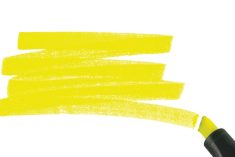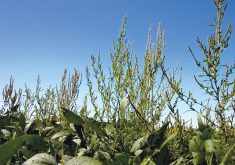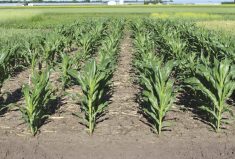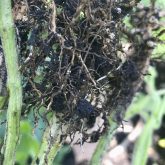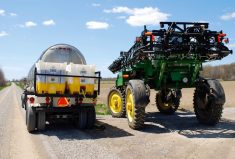If you think you’ve heard the same message about glyphosate-resistant Canada fleabane more than once, you’re probably right. But that doesn’t mean you should pay less attention, especially since it’s particularly important if you’re growing corn.
The problem of resistant biotypes isn’t getting much better, says Peter Sikkema, weed scientist with University of Guelph’s Ridgetown Campus. Glyphosate-resistant Canada fleabane across Ontario can be found in Essex County, adjacent to the Michigann border in the southwest, and east into Glengarry County, adjacent to the Quebec border. And it’s likely in all counties in between.
“I think glyphosate-resistant Canada fleabane is present across the primary agricultural region of southern Ontario,” says Sikkema. “Growers can also assume it’s multiple-resistant Canada fleabane, resistant to both Group 2 and Group 9 herbicides.”
Read Also

Producers aren’t panicking over tariffs and trade threats
The influence of tariff and trade uncertainity on farm business decisions.
Based on a survey completed in 2015, 23 of 30 counties had multiple herbicide-resistant Canada fleabane. Since its seeds are wind-dispersed, in the seven years since, the multiple-resistant biotype has probably spread to all counties, even if the seeds from in-between those regions were never tested. That’s why the safe bet today is to assume the worst.
Corn versus soybean
Glyphosate-resistant Canada fleabane is harder to control in soybean than in corn or wheat. But while corn is generally more sensitive to yield loss from weeds, soybeans are more sensitive to Canada fleabane. In field trials, Sikkema fond that average yield loss in soybean to be 61 per cent versus 52 per cent in corn.
The weed biology and the types of herbicide used also play a part in managing different weed species. For instance, Canada fleabane is a dicotyledon or broad-leaf weed; corn and wheat are monocotyledon or grass crops. In general terms, it’s much easier with herbicides to remove a dicot from a monocot crop or the reverse – to remove a monocrop weed from a dicot crop.
That has more to do with the selectivity of herbicides and less with weed competition. That’s why glyphosate-resistant Canada fleabane – although a problem in all crops – is easier to manage with the current lineup of herbicides in corn and wheat than it is in soybean.
“Corn is the higher-value crop, so the numbers may shock more,” says Sikkema, adding he gets far more calls seeking advice on how to manage glyphosate-resistant Canada fleabane in soybean than he does in corn.

Growers also have more herbicide options for managing glyphosate-resistant Canada fleabane in corn, with four pre-plant (see Table 1 at left) and 10 post-emergent herbicides that provide 90 per cent or greater control. Compare that to identity-preserved or Roundup Ready soybean, where there are far fewer effective pre-plant and post-emergent products.
The value of the four pre-plant herbicides is that they allow growers more options in introducing diversity into their weed management programs. Acuron Flexi, Calisto and Acuron all have a Group 27 while Integrity contains Groups 14 and 15. If a grower used a lot of Group 27s in the past, it’s nice to have and options where they’re not putting more selective pressure on the Group 27 products.
If there’s a note of caution that Sikkema wants to share, it’s that most post-emergence options for corn are Group 27s, including Acuron, Armezon, Callisto, Laudis, Lumax and Shieldex. That makes six of the 10 post-emergence herbicide treatments from the same group.
“For Canada fleabane, a lot of the best herbicides have a Group 27 in them, which really isn’t good from a resistance management strategy. You’d really like to have herbicides with a wider array of modes of action, just to reduce selection intensity for the evolution of herbicide-resistant weeds. Three effective post-emergence options for the control of glyphosate-resistant Canada fleabane are Group 4s — Lontrel, dicamba and Distinct — and Pardner is a Group 6.”
By the numbers
In his presentation on managing glyphosate-resistant Canada fleabane in corn, Sikkema provides a stark look at the yield loss if left uncontrolled. Yet the numbers he used were based on commodity prices in 2017. At current prices, the potential losses are much higher.
Basis of a July 14, 2022 local Ontario corn quote of $6.11 per bushel and the 2021 average yield of 175.2 bu./ac., revenue would be $1,070 per acre. At 52 per cent average yield loss, that drops to $514. As Sikkema notes, with 1,000 acres of corn, that’s a loss of more than $500,000.
“In the most competitive environment, Canada fleabane interference reduced corn yield 99 per cent on a commercial farm in Ontario,” he adds, citing a worst-case scenario. “It’s not that every field has 99 per cent but even at 52 per cent, it’s significant.”
Critical timing
At his presentations at Southwest Agricultural Conferences or during Crop Diagnostic Days, Sikkema emphasized how critical it is for growers to start with as clean a field as possible. That’s increasingly important today.
As part of his weed science course for students, he often outlines a scenario where it’s Monday morning, it’s going to rain on Tuesday and as a grower, you have corn and soybean fields and in both, the weeds are one inch tall. Which one are you going to spray?
The answer is to spray the corn, partly because of its higher sensitivity to weed interference compared to soybean.
But the good news is there are more options for post-emergence weed control in corn.
“You can apply dicamba post in Xtend soybean and get good control of your fleabane, but I am reluctant to make that recommendation due to the possibility of off-target movement,” says Sikkema. “You could apply 2,4-D post in E3 soybean and get control.”
Nowadays, some growers are becoming reluctant to apply dicamba post in Xtend soybean because of off-target movement, and there’s the same concern with 2,4-D in E3 soybean, but to a lesser degree. There are good treatments in soybean but as Sikkema puts it, the stars really have to align right to get consistently good control.
– This article was originally published in the September 2022 issue of the Corn Guide.




